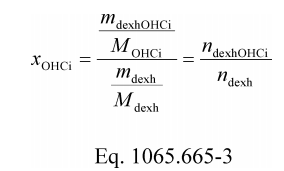['Air Programs']
['Air Emissions']
07/11/2024
...
(a) If you measured an oxygenated hydrocarbon's mass concentration, first calculate its molar concentration in the exhaust sample stream from which the sample was taken (raw or diluted exhaust), and convert this into a C1-equivalent molar concentration. Add these C1-equivalent molar concentrations to the molar concentration of non-oxygenated total hydrocarbon (NOTHC). The result is the molar concentration of total hydrocarbon equivalent (THCE). Calculate THCE concentration using the following equations, noting that Eq. 1065.665-3 is required only if you need to convert your oxygenated hydrocarbon (OHC) concentration from mass to moles:



Where:
χTHCE = the sum of the C1-equivalent concentrations of non-oxygenated hydrocarbon, alcohols, and aldehydes.
χNOTHC = the sum of the C1-equivalent concentrations of NOTHC.
χOHCi = the C1-equivalent concentration of oxygenated species i in diluted exhaust, not corrected for initial contamination.
χOHCi-init = the C1-equivalent concentration of the initial system contamination (optional) of oxygenated species i, dry-to-wet corrected.
χTHC[THC-FID]cor = the C1-equivalent response to NOTHC and all OHC in diluted exhaust, HC contamination and dry-to-wet corrected, as measured by the THC-FID.
RFOHCi[THC-FID] = the response factor of the FID to species i relative to propane on a C1-equivalent basis.
Mdexh = the molar mass of diluted exhaust as determine in §1065.340.
mdexhOHCi = the mass of oxygenated species i in dilute exhaust.
MOHCi = the C1-equivalent molecular weight of oxygenated species i.
mdexh = the mass of diluted exhaust.
ndexhOHCi = the number of moles of oxygenated species i in total diluted exhaust flow.
ndexh = the total diluted exhaust flow.
(b) If we require you to determine nonmethane hydrocarbon equivalent (NMHCE), use the following equation:

Where:
xNMHCE = the sum of the C1-equivalent concentrations of nonoxygenated nonmethane hydrocarbon (NONMHC), alcohols, and aldehydes.
RFCH4[THC-FID] = the response factor of THC-FID to CH4.
xCH4 = concentration of CH4, HC contamination (optional) and dry-to-wet corrected, as measured by the gas chromatograph FID.
(c) The following example shows how to determine NMHCE emissions based on ethanol (C2H5OH), methanol (CH3OH), acetaldehyde (C2H4O), and formaldehyde (CH2O) as C1-equivalent molar concentrations:
xTHC[THC-FID]cor = 145.6 µmol/mol
xCH4 = 18.9 µmol/mol
xC2H5OH = 100.8 µmol/mol
xCH3OH = 1.1 µmol/mol
xC2H4O = 19.1 µmol/mol
xCH2O = 1.3 µmol/mol
RFCH4[THC-FID] = 1.07
RFC2H5OH[THC-FID] = 0.76
RFCH3OH[THC-FID] = 0.74
RFH2H4O[THC-FID] = 0.50
RFCH2O[THC-FID] = 0.0
xNMHCE = xTHC[THC-FID]cor − (xC2H5OH · RFC2H5OH[THC-FID] + xCH3OH · RFCH3OH[THC-FID] + xC2H4O · RFC2H4O[THC-FID] + xCH2O · RFCH2O[THC-FID]) + xC2H5OH + xCH3OH + xC2H4O + xCH2O − (RFCH4[THC-FID] · xCH4)
xNMHCE = 145.6 − (100.8 · 0.76 + 1.1 · 0.74 + 19.1 · 0.50 + 1.3 · 0) + 100.8 + 1.1 + 19.1 + 1.3 − (1.07 · 18.9)
xNMHCE = 160.71 µmol/mol
[79 FR 23805, Apr. 28, 2014, as amended at 81 FR 74187, Oct. 25, 2016; 86 FR 34567, Jun. 29, 2021]
READ MORESHOW LESS
['Air Programs']
['Air Emissions']
Load More
J. J. Keller is the trusted source for DOT / Transportation, OSHA / Workplace Safety, Human Resources, Construction Safety and Hazmat / Hazardous Materials regulation compliance products and services. J. J. Keller helps you increase safety awareness, reduce risk, follow best practices, improve safety training, and stay current with changing regulations.
Copyright 2024 J. J. Keller & Associate, Inc. For re-use options please contact copyright@jjkeller.com or call 800-558-5011.
